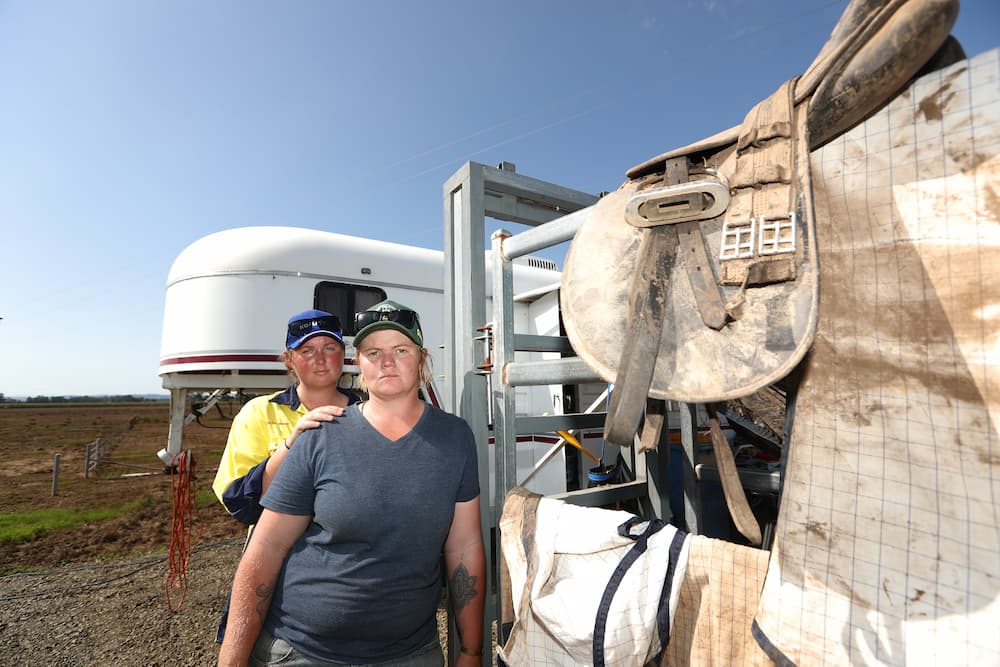Claire Wright will never forget the night a wall of water hit her northern NSW property and the sounds of her 19 horses as they slowly drowned around her.
“It was indescribable. The guttural noises coming from those animals and knowing there was nothing we could do to help them,” an emotional Ms Wright says.
Almost four weeks after the flood tore through the boutique East Coraki Australian stockhorse horse stud, the paddocks are empty and saddles sit idle.
Claire, her wife Courtney and mother Wendy Wright had stayed behind to help their animals but nothing could have prepared them for the catastrophe that arrived.
Earlier that day they’d moved some cattle to a reserve but kept the horses and a half a dozen poddy calves close-by thinking, at a metre and a half above the 1974 flood level, they would be safe.
By early morning March 1 the water had entered their house and they were forced to climb into the loft in their hayshed.
In darkness and with waters rising, it was too dangerous to leave. So they waited, watched and listened.
“It was absolutely horrendous … my wife and I were sharing headphones trying to listen to music because listening to the horses and our poddy calves bellowing all night and snorting and essentially drowning, we listened to them all night” Ms Wright told AAP.
At first light Courtney submerged herself in the deluge, removing yard pins so the horses could “fend for themselves”. But there was nowhere to swim to. Everything was underwater for kilometres.
The Wrights managed to load an orphan foal, Tradie, and his miniature horse companion Larry onto a truck. Belly-deep in water, they would stay there for a week.
Despite calls to emergency services no one came to help. It wasn’t until mid morning that the women were rescued by a neighbour in a boat.
“The response just wasn’t quick enough,” Ms Wright says.
“Following the flood, the support was very delayed and a lot of livestock was lost due to the delay.”
She wants an overhaul of response procedures and a government database set up to track deceased animals before they’re disposed of.
Details like gender, markings and brandings on the carcasses could be used to let owners know they’ve been found.
“I’ve still got 13 missing that I don’t know about,” Ms Wright says.
“I assume they’re dead but there’s always that niggling doubt; maybe one got away, maybe someone’s looking after it.
“People need to know.”
Their old stallion, young colt, foals, brood mares including those in foal, competition horses are all gone, Ms Wright says.
“They’re all registered, they’re all branded they’re all part of our family. They’re our whole lives; our whole lives are based around the care of our animals.”
Equine vet Oliver Liyou says thousands of cattle, horses, sheep and goats are missing since the flood, the majority feared dead.
“We need an identification process of carcasses, which must involve multi government and private agencies,” he says.
“Until we have that their true fate may never be known.”
Veterinary practice manager Lara Johnston says she has pleaded with local bureaucrats to set up a database to give people closure.
“This isn’t the first time this has happened and will not be the last,” she says.
“I just can’t imagine being in that position, where you’ve lost your home, you’ve lost your livelihood you just want to find some piece of your family and for some people they’ll never know.”
Many horses that washed up on public land were pets with owners desperate to find them, Ms Johnston says.
“There is still hope, there are still people posting photos of their horse … they’re still thinking they’re out there.”
Most need something to grasp so they can move on but there’s also the financial side of things,” she says.
“Some of this stock was insured and now they have to jump through hoops because they can’t prove (their animals) are dead.”
Under NSW emergency response provisions, animal welfare is the responsibility of the Agriculture and Animal Services Functional Area, with Local Land Services working with the Department of Primary Industry.
Given the enormity of the flood, the AASFA says the focus has been on disposing of animals quickly and safely to limit the risk of disease and other contamination.
Where possible, animals have been scanned and matched with owners.
Meanwhile the Wrights are coming to terms with losing members of their “family”.
“The worst part about coming home is not seeing any of our horses, knowing the paddocks are empty, not being able to have a cuddle,” Claire says.
The financial toll has also been hefty, with just one of their dead horses worth $50,000.
They say they’ve been reliant on a GoFundMe page to pay vet bills and haven’t decided yet whether they will start again.
Get all the latest Canberra news, sport, entertainment, lifestyle, competitions and more delivered straight to your inbox with the Canberra Daily Daily Newsletter. Sign up here.



